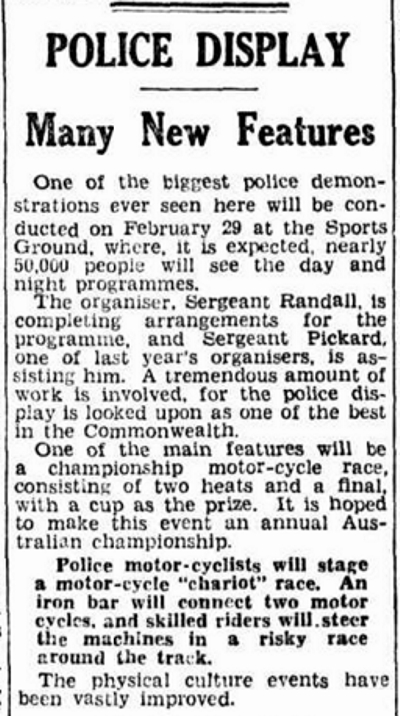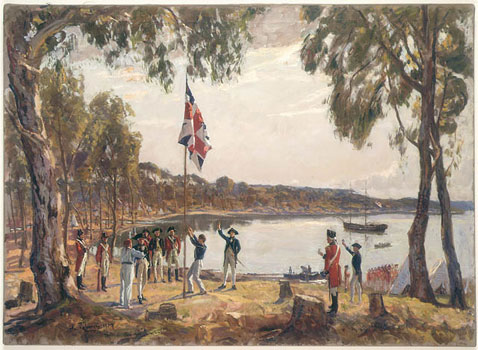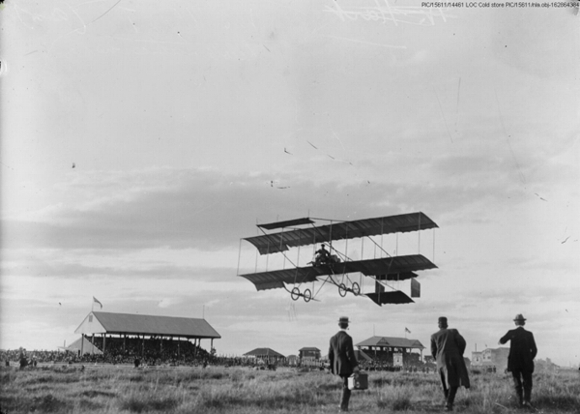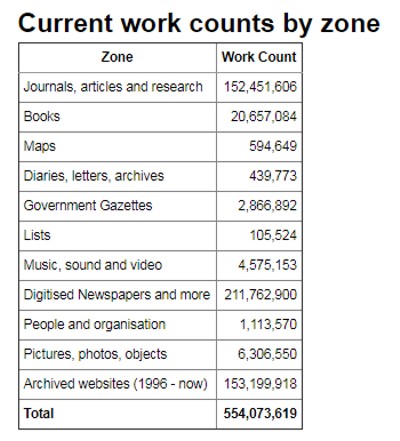Australia’s Motorcycle Chariot Race
Chariots are something from the Roman era, and not something to you associate (or see) these days, or even in the relatively recent past.
But back in 1920s-1930s chariot motorcycle racing was a thing. Yes, for real! And Australia even got in on the act.
I recently saw the photo above, on the History in Pictures Facebook page, and couldn’t believe what I saw.
Two men in Roman style outfits, in chariots, with two motorbikes pulling them along. The caption read “Motorcycle Chariot Race in New South Wales, Australia, 1936”. I was intrigued, I wanted to know if this was for real, so I headed to Trove.
Sure enough, the motorcycle chariot race did happen. It was one of many events that were held at Sydney Showgrounds for the New South Wales Police Carnival on Saturday, 29 February 1936. With an estimated crowd of 50,000 this was AN EVENT!!
Here’s just some of the articles I found on Trove about it …

9 January 1936, The Sun, p. 21
http://nla.gov.au/nla.news-article230085708

practicing for the event, 14 February 1936, Sydney Morning Herald p. 14 http://nla.gov.au/nla.news-article17332942

The Sun, 30 January 1936, p. 36
http://nla.gov.au/nla.news-article230082544
And to top it off there’s even a short video up on YouTube of the race.
The National Film and Sound Archive (NFSA) have a great write up about the NSW Police Carnival day, together with a longer video showing more of the events, which is totally worth watching. Check that out here.
And for the record, there was going to be two heats (two laps each), but a third was needed to determine the winner:
Heat 1: Constable J. T. Riley 1, Constable Langham 2. Time, 59 3-5.
Heat 2: Constable Langham 1, Constable Riley 2. Time, 60 2-5.
Heat 3: Constable Riley 1, Constable Langham 2. Time, 1.1¾.

2 March 1936, The Sydney Morning Herald, p. 10.
http://nla.gov.au/nla.news-article17316443
So from seeing a very cool random vintage photo online, to a history lesson … what’s not to love about history … and motorcycle chariot racing!
21 Facts About the First Fleet
Did you know that approximately 20% of Australians descend from convicts … yes, true! Having a convict in the family has become a badge of honour for many, and having a First Fleeter even more so.
And while the term ‘convict’ tends to mean ‘criminal’, so many of the 162,000 who were transported to Australia weren’t actually ‘bad’. In fact, many were just trying to survive.
So just how much do you know of your Australian convict history? In particular the First Fleet? Here’s some intriguing facts that you probably didn’t know.
- Why send convicts to Australia?
Britain had shipped about 52,000 convicts to America between 1717 and 1775 before they started sending them to Australia. And it was because of the American Revolution in 1776 that Britain started sending their criminals to Australia. - When and where did it leave from and arrive?
The fleet left Portsmouth, in Hampshire, England on 13 May 1787, and arrived at Botany Bay, New South Wales, Australia between 18-20 January 1788 - How many ships in the first fleet?
The whole fleet consisted of 11 ships. 6 convict ships, 2 naval ships and 3 ships with supplies - What are the names of the ships in the first fleet?
H.M.S. Sirius, Charlotte, Alexander, Scarborough, Lady Penrhyn, Friendship, H.M.S. Supply, Prince of Wales, Golden Grove, Fishburn and Borrowdale - Who was the captain of the first fleet?
Captain Arthur Phillip - What about Port Jackson?
The fleet arrived at Botany Bay but as that place was deemed unsuitable as a settlement due to the lack of fresh water, the fleet sailed on to Port Jackson (Sydney Cove), New South Wales arriving on 26 January 1788 - What’s so special about the date 26 January?
26 January marks the anniversary of the 1788 arrival of the First Fleet of British ships at Port Jackson, New South Wales and the raising of the British flag at Sydney Cove by Governor Arthur Phillip, which signifies the beginning of European settlement in Australia. - How long did the first fleet voyage take?
The voyage took 259 days (8 months and 14 days) - Did the fleet stop anywhere along the way?
They sure did. They stopped at Tenerife (Canary Islands), Rio de Janeiro (Brazil) and Cape Town (South Africa) on the way to stock up on food and supplies. - How many convicts were on the first fleet?**
When the ships left England there was a total of 1420 people onboard: Officials and passengers 15, Crew 323, Marines 247, Marines wives and children 46, Male convicts 582, Female convicts 193, Convicts’ children 14 - How many convicts arrived in New South Wales?**
When the ships arrived there was a total of 1373, due to some deaths on the voyage: Officials and passengers: 14, Crew: 306, Marines: 245, Marines wives and children: 54, Male convicts: 543, Female convicts: 189, Convicts’ children: 22** - How big were the first fleet ships?
Alexander, weighing in at 452 tons, 114ft (34.7m) long and 31ft (9.4m) wide the Alexander was the largest ship in the fleet. To put it in perspective the ship was just a little larger than the size of a standard tennis court. - What were the crimes of the convicts?
The most common were: Petty theft, Burglary or housebreaking, Highway robbery, Stealing clothing, Stealing animals, Military offences, Prostitution, Crimes of deception, and Political protest. - Who was the youngest female convict?
Elizabeth Hayward/Haywood was aboard the Lady Penrhyn and was the youngest female convict on the First Fleet. She was 13 when sentenced, and 14 when the first fleet sailed. Her crime was stealing a linen gown and a silk bonnet. She was an apprentice clog maker before she was transported. - And the youngest male convict is …
John Hudson a ‘sometimes’ chimney sweeper, at 9 years old, and the youngest First Fleet convict at the time of sentencing, was tried at the Old Bailey in London in December 1783, to seven years transportation for breaking and entering a dwelling house. He was 13/14 when he was transported. - What nationality were the convicts?
Most were English, Irish or Scottish, but there were also some African, American and French convicts on the first fleet. - Religion and the first fleet …
It’s well known that religion came to Australia with the first fleet. A reasonable portion of the convicts identifying themselves as Christian. - And the first church service held on Australian soil was …
The fleet arrived at Port Jackson on January 26th, on the following Sunday, February 3rd the first church service was held for the officers, marines and convicts on Australian soil. The service was led by the colony’s Chaplain, the Reverend Richard Johnson, on a grassy hill under a tree - What were some of the items brought on the storeships?
This is a small sampling of the stores: 6 butcher’s knives, 10,000 bricks, 18 coils of whale line, harness for 6 horses, 8 dozen pounds of sewing twine, 10 smith’s bellows, 7 dozen razors, 127 combs, 1 portable canvas house for Gov. Phillip), 589 women’s petticoats, 250 women’s handkerchiefs, 10 pairs of handcuffs, mill spindles, 10 forges, 700 spades, 700 west india hoes, 747,000 nails, 40 wheel barrows, 30 grindstones, and even a printing press. They also brought seeds, and many fruit trees. - What animals came out with the first fleet?
18 turkeys, 29 geese, 35 ducks, 122 fowls, 87 chickens, kittens, puppies, 4 mares, 2 stallions, 4 cows, 1 bull, 44 sheep, 19 goats, 32 hogs, 5 rabbits, as well as Governor Phillips’ greyhounds, and Rev. Johnson’s cats - The 26th of January hasn’t always been called “Australia Day”, so what was it known as?
It was originally known as “First Landing Day” or “Foundation Day”, and there’s evidence of these celebrations taking place that date back to the early 1800s. However it wasn’t until 30 years after the landing, that the first “official” celebrations were held in 1818. But as each Australian state was it’s own colony, and politics being politics, it took until 1935 to settle on a uniform date for all states to agree on, and named as Australia Day.

The Founding of Australia, 26 January 1788, by Captain Arthur Phillip R.N., Sydney Cove. [Original oil sketch (1937) by Algernon Talmadge R.A. ML1222]
– Here’s a map of the journey taken by the First Fleet.
– Search for the names of the convicts on the First Fleet here
As a side note, if you find a convict if your family history, you have Australian royalty (as it’s known). However if you can lay claim to being descended from a First Fleet convict, then you have ‘true’ Australian royalty.
**[Please Note: the numbers vary depending on the report. But there were over 710, and can be up to 780]
6 January 1912 – Australia’s First Plane Crash
6 January 1912, is the date Australia’s first official plane crash happened.
But before going into that, just a little background information.
Australia’s earliest recorded attempts at powered flying took place in 1909, and within a year, numerous aircrafts were being imported, with others being locally made. As you can imagine, some of these new flying machines proved less successful than others, with mild accidents on take-off occurring in several cases. However it was inevitable that a ‘proper’ aeroplane crash would take place sooner or later.
William Ewart Hart is the man who’s name is now in Australia’s history as being the pilot of Australia’s first plane crash.
Billy Hart (as he was known) was born in Parramatta, New South Wales in 1885, when at age 16 he was apprenticed to a local dentist. By 1906 was a registered dentist himself, and after registration he practiced as a dentist in Wyalong, where he rode the first motorcycle and drove the first car in town. Quite the man, no doubt! He went on to practice in Newcastle, New South Wales.
In 1911, at age 26 Billy Hart learnt to fly and became the first man to hold an Australia aviator’s licence. His No. 1 Certificate of the newly-created Aerial League of Australia was granted on 5 December 1911. Hart imported a British aircraft for £1300 (approx $140,000 today), and maintained it in a tent at Penrith, New South Wales. However, shortly after its purchase, strong winds overturned the tent and the plane, reducing the aircraft to a wreck.

William Ewart Hart in his Bristol Boxkite Biplane, 1912.
(State Library of New South Wales, Ref: PXA 1063 / 276)
Not to be defeated, Billy salvaged what he could, and built a biplane from the parts. On 6 January 1912 he was demonstrating his aircraft, and had military officer Major Rosenthal as a passenger, however when he was at a height of 180m (approx 600 feet), he hit turbulence and began to lose altitude. As it dropped, the biplane hit a signal post, then came to rest upside down beside the railway line, so this is Australia’s first ‘official’ aeroplane crash. You can read about this incident in the detailed report that appeared in the Geelong Advertiser.
Although he sustained some minor injuries, Hart and his passenger survived, and he was inclined to blame the Major’s weight for the crash. His words were reported as follows: “It really was a trial run and when I say that Major Rosenthal weighed 17 stone (about 107kg) the test my machine was put to will be understood.”

Dentist William Hart, holder of Australian pilot licence number 1 flying a bi-plane, Sydney, ca. 1912 [NLA reference: PIC/15611/14461 LOC Cold store PIC/15611]

details of the crash in The Australasian, (Melbourne, Vic.) p. 41. 7 September 1912 http://nla.gov.au/nla.news-article143277314
Billy Hart continued dentistry, and died of heart failure in 1943 at the age of just 58.
He was said to be a remarkable man, respected and admired Vice President of the Air Force Association and to quote from their minutes: “resourceful, courageous pioneer,
soldier, airman, loyal friend and good citizen, lovable personality, and gallant gentleman.
You can read more about William Ewart “Billy” Hart here;
– Wikipedia
– Australian Dictionary of Biography
– Parramatta Heritage Centre
Trove – Eight Years of Incredible Discoveries
Eight years ago, the way of historical and genealogical research in Australia changed forever. Trove went live.
Created by the National Library of Australia, the Trove website is a portal to their absolutely incredible collection of records.
By “absolutely incredible”, I’m talking millions of records. But not “just” millions. How about 554,000,000 of them? That’s right, over HALF A BILLION of them in fact! All online and all free to search. So how lucky are we?
There’s no doubt that Trove is Australia’s number 1 website for research. If it’s not yours, it should be! So go and bookmark it www.trove.nla.gov.au now.
If you’re not familiar with Trove, take a quick look at the videos below that give you a quick overview, of what it is, and the different facets to it.
So you’ll find photos, journals and articles, archived websites, government gazettes, music, sound and video recordings, diaries and letters, maps and books, even vintage issues of the Women’s Weekly magazine. They all make up the phenomenal collection of Australian history that the National Library of Australian (NLA) looks after. For more a detailed analysis on using Trove and all it’s facets, check out Shauna Hicks’ “Trove: Discover Genealogy Treasure in the National Library of Australia“.
However what most researchers (myself included) head to Trove for, is their historical newspaper collection. And why wouldn’t we, they are so fun. And with over 200 million pages of old newspaper online already – there are so many stories just waiting to be found.
The blog theme “Trove Tuesday” was started back in 2012 by Amy Houston of the Branches Leaves and Pollen blog, [note, I know the link has changed, but I still wanted to give her the credit], and through its creation, has inspired so many to find and share their amazing discoveries using Trove.
Just having a quick look through my own Trove Tuesday posts, and I’ve done articles on obituaries, the opening of a butter factory, drink ‘driving’, a hanging, a duel, several WW1 and WW2 related entries, local football match, Adelaide’s water supply, gold, South Australian pioneers, an earthquake, Christmas, the plague, a sudden death, a ploughing match … and so much more.
None of this would have been easily accessible without the online newspapers on Trove. The detail in a newspaper article is often better than you’ll find anywhere else , so it is a valuable source of information.
So I wish to say a huge CONGRATULATIONS to the National Library of Australia team for Trove’s 8th birthday, and THANKYOU, THANKYOU, THANKYOU for giving us the present of Trove.
And one last note, if you come across the following terms, here are their definitions:
– BT – before Trove
– pre-Trove – life before Trove
– post-Trove – life after Trove went live
– Troveite – a person addicted to searching Trove’s newspapers
and for even more Trove related lingo, be sure to check out a heap more at Carmel’s Library Currents blog
Related Articles:
13 Tips For Searching Trove’s Historical Newspapers





